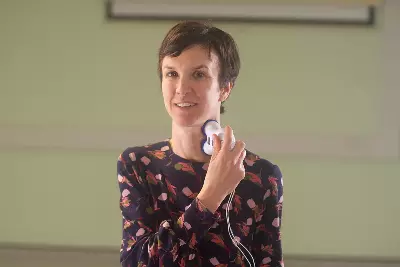Could a handheld device help reduce falls?
Balance and falls are a major concern for people with Parkinson’s. Find out how new research aims to address this through the use of an easy to use handheld device.
The brain cells that are affected by Parkinson’s have a vital job to do. They release important chemicals that tell the body how to function. You may have heard of dopamine before, but one of the other chemicals released by these brain cells is called acetylcholine.
We know that acetylcholine is involved in memory, thinking and walking. And researchers believe that changes in acetylcholine levels, caused by the gradual loss of brain cells, may contribute to why people with Parkinson’s are at increased risk of falling.
Balance is such a huge issue that, when over 1,000 people with Parkinson’s, their families and professionals were asked what symptoms they most wanted research to address, improving balance and preventing falls was number one on their list.
Find out more about the research priorities for people with Parkinson's.
Christine shared with us how Parkinson’s impacts her movement:
"I am faced with navigating a world with movement problems every day. This is most difficult when I have to take public transport. I have to negotiate moving around people and narrow spaces as my Parkinson’s affects my visual processing when making a movement. I call it 'think walking'. I have to plan my route and exaggerate my movements in order to get from point A to B."
Now, new research led by Dr Alison Yarnall and funded by Parkinson’s UK aims to investigate whether a handheld device could improve walking in people with Parkinson’s.
Alison, who runs her own Parkinson’s clinic at a hospital in Newcastle, often sees people, like Christine, who are struggling with their balance and are worried about falling.
"People get frightened of falling, so they become less active. And the irony is that because they don’t use their muscles much, they’re even more likely to fall when they do. We hope to break that cycle by improving the mobility of people with Parkinson’s."
Dr Alison Yarnall
Dr Yarnall and her team plan to investigate a device that emits small electrical impulses onto the skin to stimulate the nerves underneath, to see if this can improve walking and reduce falls.
The nerve they will be stimulating is the vagus nerve, which connects the brain to the rest of the body and plays an important role in controlling many of our bodily functions.
Stimulating the vagus nerve could help boost the release of vital brain chemicals and could hold promise for a number of conditions, including epilepsy, migraines and some psychiatric conditions. This will be one of the first studies to test if this type of therapy may help in Parkinson’s.
Read more about vagus nerve stimulation on the National Library of Medicine website.
Stimulating brain cells in Parkinson’s
Electrical stimulation to boost the function of brain cells is already used as a therapy to treat Parkinson’s. The treatment is known as deep brain stimulation and involves implanting electrodes into the brain so electrical stimulation can be applied directly to the brain cells. The electrodes are connected to a battery pack under the chest, which controls the stimulation being given to the brain. Now researchers believe brain cells can be boosted by stimulating nerves in the neck that are connected to the brain in a non-invasive way.
Read more about nerve stimulation and other non-drug therapies under investigation for Parkinson’s.
What does Dr Yarnall’s research involve?
A small handheld device will be placed on the neck to stimulate the vagus nerve. The researchers hope this will increase the amount of acetylcholine available in the brain and improve coordination in people with Parkinson’s, improving walking and reducing the risk of falls.

This new study builds on promising results from a small pilot trial. 40 people with Parkinson’s will take part in this stage of the research and will either be given a device that can stimulate the vagus nerve or a placebo device that looks and feels similar but does not provide active treatment. The handheld device will be given to participants to use twice a day at home for 12 weeks. Memory, walking and brain activity will be measured to help understand if the device is beneficial. The researchers will also continue to monitor people after they have stopped using the device to see if there are any long term benefits.
Can I take part in this research?
The researchers are busy designing the clinical trial and hope to launch soon. We keep people up to date on all new opportunities to take part in research studies with our Research Support Network emails. Sign up to join the Research Support Network.
How close are we to a new treatment?
There is a desperate need to speed up research to deliver new treatments for Parkinson’s.
Because this device has already been approved for other conditions, should it be shown to be beneficial, it could quickly change the lives of those with Parkinson’s.
Your donation is needed to find out if this device works. With your support, we could see a brand new treatment for one of the most troublesome symptoms affecting those with Parkinson’s become widely available within a few years.
Support research breakthroughs
We're leading the way to better treatments and together, we will find a cure. Will you join us?
